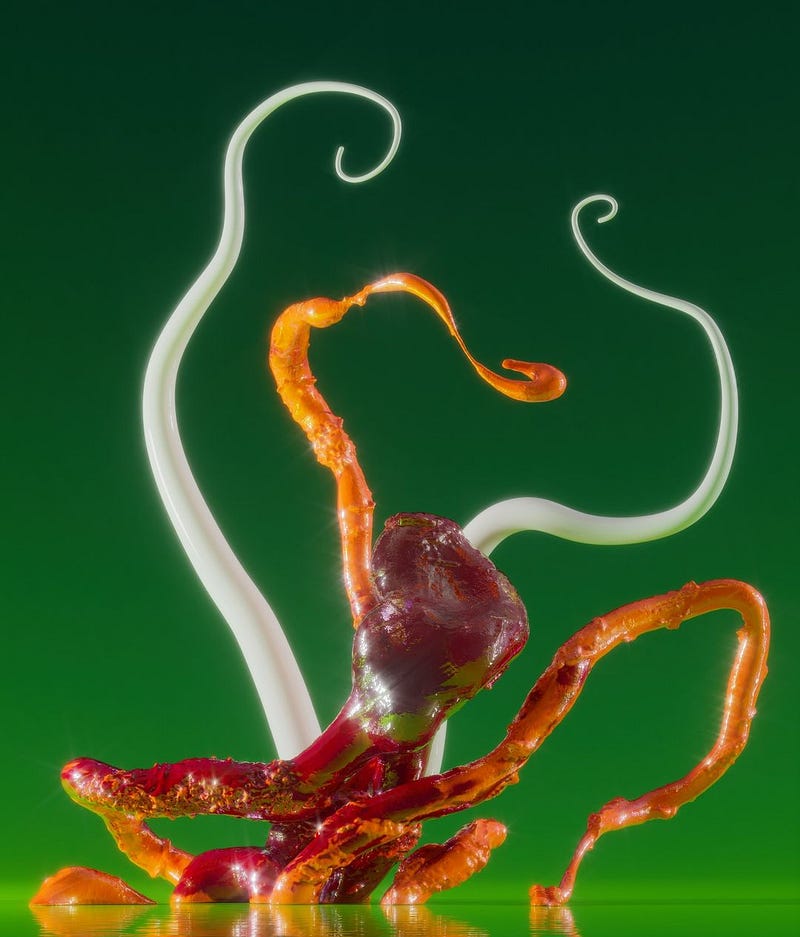Analyzing the Artists’ Excavation of In-Betweens
Faced with The Internet Office’s aeriform digital sculptures, I am overcome by a feeling of ambiguity. I am tempted to define this feeling as a residue from witnessing a series of opposing forces clash, but that would be a gross oversimplification. The Internet Office’s work seductively resides in an “in-between” space more than in a realm of antagonisms. In-between a hypothesis and a thesis, simplicity and complexity, the organic and the inorganic, hard and soft, wet and dry, chaos and order. In-between stillness and movement. These forces are not colliding, but are working together to create a new, third space for contemplation.

These juxtapositions create a soft, muted kind of conflict, a transitive framing for the entanglement between possibilities of form, matter, and the digital. An infinite mathematical landscape of the intangible, which is now transformed into a fictional survey of the almost possible but not quite. There doesn’t seem to be a firm statement in The Internet Office’s broader approach to image making other than their highly-arbitrary positioning of an object of contemplation. This gesture becomes powerful in its simplicity, spawning nuance and elusiveness. As if a single frame is being stolen from a larger moving sequence, a protagonist appears on stage. The lights are on, and so is the show. Within the gesture of choosing something to be observed, the strength of the compositional frame-working manifests, as if these resolutions were more archaeological than purely aesthetic.
The idea that all these individual pieces are part of something larger — in this case a lone captured frame within a moving sequence — puts the work in an environment somewhere between the real and the fictional, creating a bewildering back-and-forth that blurs lines more than it sets boundaries. Since many of The Internet Office’s works began as procedural computational processes, like 3D simulations, and the subsequent choosing of an arbitrary moment within that time frame, it makes sense that the result should seem like a slit of something much longer, a sort of transitory sample. I keep coming back to the idea of a musical phrase. A subtle, very short visual idiom. A brief but compelling poem.

In 1859, Oliver Wendell Holmes, a poet and physician, when talking about photography, stated that:
“Form is henceforth divorced from matter. In fact, matter as a visible object is of no great use any longer, except as the mold on which form is shaped.”
This statement reflects a time when photography was kickstarting the journey towards an increasingly complex relationship with materiality in the conception of image, especially for art-making. As photography became popular and widely-accessible, art itself began progressively journeying towards ephemerality, becoming more and more intangible. This study of materiality reached a high-point during the Conceptualism of the ’50s, intensified with the inclusion of performance art and art happenings as accepted mediums for expression, and have reached another significant milestone recently with NFTs and digital art experiencing a cultural surge. In this context, the digital exploration of material-seeming structures, and their potential for floating back IRL to become tangible objects again, feels like a peculiar paradox. Somehow, The Internet Office works within a liminal space where the image turns back into its ideal form, its essence, where means and ends (form and matter) mingle until indiscernible from one another.
The Internet Office’s work with the possibilities of digital materiality is an exploration of yet another in-between: that between dead and living. Organic and inorganic intertwine until there is no clear distinction. Like a techno-Frankenstein, their uncanny sculptures sit awaiting contemplation, gracefully and peacefully, proposing the existence of a parallel reality. During a conversation about the ideas behind their work, they mentioned the concept of “wetware,” the likening of neuro-biological processes as a third category on a par with software and hardware. This nod to cyberpunk culture, techno-body-mods and bio-cybernetics is greatly suitable for placing these works in context, both in the sense of creating fictional universes and in the weakening of boundaries between the lifeless and the biotic.

This path towards material and organic exploration feels more apropos today than ever, as The Internet Office’s work, in this sense, looks into perhaps the most complex in-between of all: that of biology and technology. Their practice is moving towards exploring a highly problematic aspect of human development, a process that leaves behind a farrago of imaginaries that are both aesthetically-engaging and philosophically-thorny. The interfacing of humans with machines is becoming increasingly more direct, with everyday devices becoming more and more like peripheral augmentations of human cognition. Identities online are increasingly indiscernible from offline; Metaverse and universe seem to be closer together each week as experiences become smoother, more massive, and more mainstream. In this context, the delicate but profound enunciation behind The Internet Office’s digital objects is one of major relevance: The lines are getting fainter. Once the limits of what can exist have been pushed, handled, broken, all that is left is the one true object. A mysterious one that can’t really be placed in any one single space.
